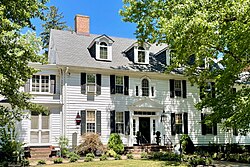Fernbrook Farms
United States historic place From Wikipedia, the free encyclopedia
United States historic place From Wikipedia, the free encyclopedia
Fernbrook Farms is a 230-acre (93 ha) working farm located along County Route 545 (Bordentown-Georgetown Road) in Chesterfield Township in Burlington County, New Jersey. Originally an 18th-century farm, it was briefly a stock breeding farm, known as the New Warlaby Stock Farm, in the 19th century. It now includes an inn, plant nursery, environmental education center, and community-supported agriculture.[4] It was added to the National Register of Historic Places on July 7, 2022, for its significance in architecture and landscape architecture.[5]
Fernbrook Historic District | |
 John Newbold House, c. 1761 The Inn at Fernbrook Farms | |
| Location | 142–150 Bordentown-Georgetown Road Chesterfield Township, New Jersey |
|---|---|
| Coordinates | 40°6′14″N 74°40′37″W |
| Area | 111 acres (45 ha) |
| Architectural style | Federal, Shingle, Stick, Colonial Revival |
| NRHP reference No. | 100007873[1][2] |
| NJRHP No. | 5577[3] |
| Significant dates | |
| Added to NRHP | July 7, 2022 |
| Designated NJRHP | May 16, 2022 |
In 1760, John Newbold acquired 500 acres (200 ha) of farm land along the Fern Brook from his father Michael Newbold. He then built a two and one-half story frame farmhouse for the estate, c. 1761. The house was expanded in 1791 by adding two bays. In 1881, Charles Morgan purchased 290 acres (120 ha) to raise premium breeding cattle. In 1897, John L. Kuser moved there, and in 1899, he purchased the property. After his death in 1937, his son Walter G. Kuser inherited the property. Lawrence Kuser and his wife Susie started living there in 1974.[5]
The Fernbrook Historic District is a 111-acre (45 ha) historic district encompassing the core part of the farm. It was added to the National Register of Historic Places on July 7, 2022, for its significance in architecture and landscape architecture. The district has eleven contributing buildings, six contributing structures, and one contributing site. The Federal-style John Newbold House is the main contributing property in the district. A cedar shaked water tower, built c. 1897, provided water pressure and filtration for Morgan's mansion and the formal Colonial Revival gardens.[5]
In 1881, having inherited money, Morgan imported premium breeding cattle from England, paying nearly US$20,000 for them. They were shorthorns of the Booth stock from Warlaby. He renamed the farm, New Warlaby, and established a model breeding farm.[5][6] However, by 1885, he had sold the cattle to Leslie Combs of Kentucky.[7]
A plant nursery operation was started in the 1970s. A community-supported agriculture (CSA) component was added in 2007.[5]
In 2001, Larry and Susie Kuser established an environmental education center on the property.[5][8]
Seamless Wikipedia browsing. On steroids.
Every time you click a link to Wikipedia, Wiktionary or Wikiquote in your browser's search results, it will show the modern Wikiwand interface.
Wikiwand extension is a five stars, simple, with minimum permission required to keep your browsing private, safe and transparent.